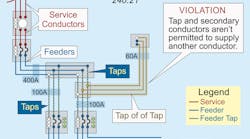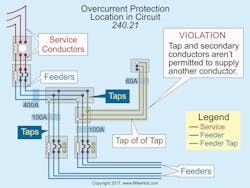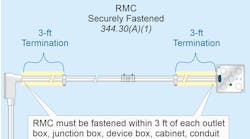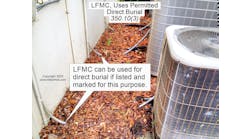All questions and answers are based on the 2017 NEC.
Q. Per the NEC, overcurrent protection devices must be placed at what location in branch-circuit or feeder conductors?
A. Except as permitted by Sec. 240.21(A) through (H), overcurrent protection devices must be placed at the point where the branch-circuit or feeder conductors receive their power. Taps and transformer secondary conductors aren’t permitted to supply another conductor (tapping a tap isn’t permitted) [240.21], as shown in the Figure.
Branch-circuit tap conductors are permitted in accordance with Sec. 210.19, and can have overcurrent protection as required by Sec. 210.20 [240.21(A)].
Conductors can be tapped from a feeder (feeder taps) as specified in Sec. 240.21(B)(1) through (B)(5). The “next size up overcurrent protection rule” of Sec. 240.4(B) isn’t permitted for tap conductors [240.21(B)].
10-Ft Feeder Tap Rule
Feeder tap conductors up to 10 ft long are permitted without overcurrent protection at the tap location if the tap conductors comply with the following [240.21(B)]:
(1) The tap conductors must have an ampacity less than:
a. The calculated load in accordance with Article 220, and
b. The rating of the overcurrent protection device termination or equipment containing overcurrent protection devices supplied by the tap conductors.
Exception to b: Listed equipment, such as a surge protection device, can have their conductors sized in accordance with the manufacturer’s instructions.
(2) The tap conductors must not extend beyond the equipment they supply.
(3) The tap conductors are installed within a raceway when they leave the enclosure.
(4) The tap conductors must have an ampacity not less than 10% of the rating of the overcurrent protection device that protects the feeder.
Informational Note: See Sec. 408.36 for the overcurrent protection requirements for panelboards.
Let’s run through an example problem to drive this point home.
Example: A 400A breaker protects a set of 500kcmil feeder conductors. There are three taps fed from the 500kcmil feeder that supply disconnects with 200A, 150A, and 30A overcurrent protection devices. What are the minimum size conductors for these taps?
Answer:
• 200A Disconnect Tap: 3/0 AWG is rated 200A at 75°C and is greater than 10% of the rating of the overcurrent protection device (400A).
• 150A Disconnect Tap: 1/0 AWG is rated 150A at 75°C and is greater than 10% of the rating of the overcurrent protection device (400A).
• 30A Disconnect Tap: 8 AWG rated 40A at 60°C. The tap conductors from the 400A feeder to the 30A overcurrent protection device can’t be less than 40A (10% of the rating of the 400A feeder overcurrent protection device).
25-Ft Feeder Tap Rule
Feeder tap conductors up to 25 ft long are permitted without overcurrent protection at the tap location if the tap conductors comply with the following [240.21(B)(2)]:
(1) The ampacity of the tap conductors are not permitted to be less than one-third the rating of the overcurrent protection device that protects the feeder.
(2) The tap conductors terminate in an overcurrent protection device rated no more than the tap conductor ampacity in accordance with Sec. 310.15 [Table 310.15(B)(16)].
Outside Feeder Taps of Unlimited Length Rule
Outside feeder tap conductors can be of unlimited length, without overcurrent protection at the point they receive their supply, if they comply with all the following [240.21(5)]:
(1) The outside feeder tap conductors are protected from physical damage within a raceway or manner approved by the authority having jurisdiction.
(2) The outside feeder tap conductors terminate at a single overcurrent protection device that limits the load to the ampacity of the outside feeder tap conductors.
(3) The terminating overcurrent protection device for the outside feeder tap conductors is part of the building feeder disconnect.
(4) The building feeder disconnecting means is readily accessible, either outside the building, or nearest the point of entrance of the outside feeder tap conductors.
These materials are provided to us by Mike Holt Enterprises of Leesburg, Fla. To view additional Code training materials offered by this company, visit www.mikeholt.com.





